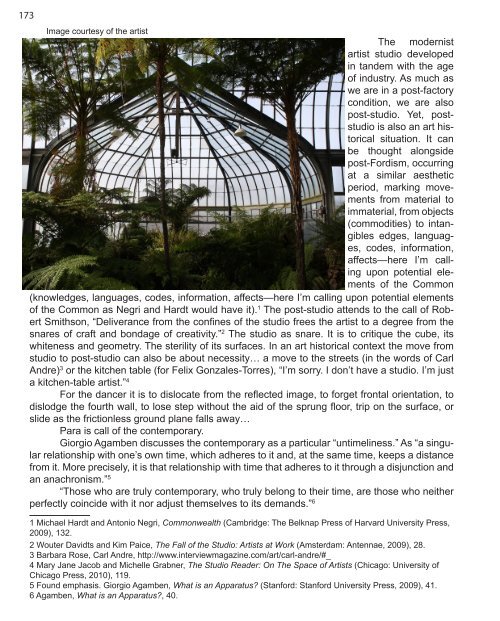Detroit Research Volume 1
Create successful ePaper yourself
Turn your PDF publications into a flip-book with our unique Google optimized e-Paper software.
173<br />
Image courtesy of the artist<br />
The modernist<br />
artist studio developed<br />
in tandem with the age<br />
of industry. As much as<br />
we are in a post-factory<br />
condition, we are also<br />
post-studio. Yet, poststudio<br />
is also an art historical<br />
situation. It can<br />
be thought alongside<br />
post-Fordism, occurring<br />
at a similar aesthetic<br />
period, marking movements<br />
from material to<br />
immaterial, from objects<br />
(commodities) to intangibles<br />
edges, languages,<br />
codes, information,<br />
affects—here I’m calling<br />
upon potential elements<br />
of the Common<br />
(knowledges, languages, codes, information, affects—here I’m calling upon potential elements<br />
of the Common as Negri and Hardt would have it). 1 The post-studio attends to the call of Robert<br />
Smithson, “Deliverance from the confines of the studio frees the artist to a degree from the<br />
snares of craft and bondage of creativity.” 2 The studio as snare. It is to critique the cube, its<br />
whiteness and geometry. The sterility of its surfaces. In an art historical context the move from<br />
studio to post-studio can also be about necessity… a move to the streets (in the words of Carl<br />
Andre) 3 or the kitchen table (for Felix Gonzales-Torres), “I’m sorry. I don’t have a studio. I’m just<br />
a kitchen-table artist.” 4<br />
For the dancer it is to dislocate from the reflected image, to forget frontal orientation, to<br />
dislodge the fourth wall, to lose step without the aid of the sprung floor, trip on the surface, or<br />
slide as the frictionless ground plane falls away…<br />
Para is call of the contemporary.<br />
Giorgio Agamben discusses the contemporary as a particular “untimeliness.” As “a singular<br />
relationship with one’s own time, which adheres to it and, at the same time, keeps a distance<br />
from it. More precisely, it is that relationship with time that adheres to it through a disjunction and<br />
an anachronism.” 5<br />
“Those who are truly contemporary, who truly belong to their time, are those who neither<br />
perfectly coincide with it nor adjust themselves to its demands.” 6<br />
1 Michael Hardt and Antonio Negri, Commonwealth (Cambridge: The Belknap Press of Harvard University Press,<br />
2009), 132.<br />
2 Wouter Davidts and Kim Paice, The Fall of the Studio: Artists at Work (Amsterdam: Antennae, 2009), 28.<br />
3 Barbara Rose, Carl Andre, http://www.interviewmagazine.com/art/carl-andre/#_<br />
4 Mary Jane Jacob and Michelle Grabner, The Studio Reader: On The Space of Artists (Chicago: University of<br />
Chicago Press, 2010), 119.<br />
5 Found emphasis. Giorgio Agamben, What is an Apparatus (Stanford: Stanford University Press, 2009), 41.<br />
6 Agamben, What is an Apparatus, 40.





